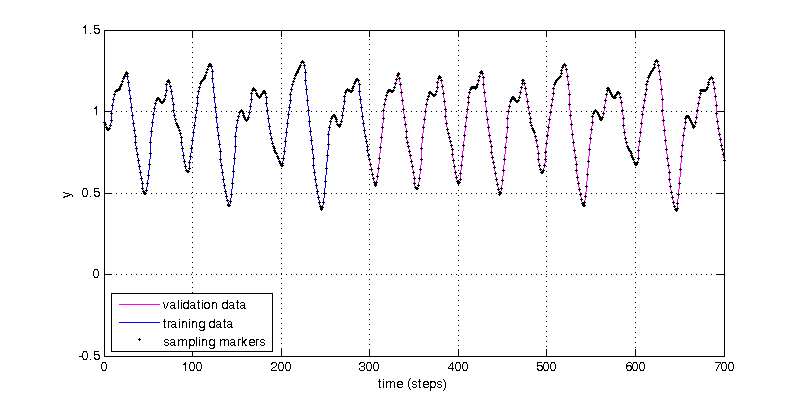Prediction of chaotic time series with NAR neural network
Neural Networks course (practical examples) © 2012 Primoz Potocnik
PROBLEM DESCRIPTION: Design a neural network for the recursive prediction of chaotic Mackay-Glass time series, try various network architectures and experiment with various delays.
Contents
Generate data (Mackay-Glass time series)
close all, clear all, clc, format compact % data settings N = 700; % number of samples Nu = 300; % number of learning samples % Mackay-Glass time series

b = 0.1; c = 0.2; tau = 17; % initialization y = [0.9697 0.9699 0.9794 1.0003 1.0319 1.0703 1.1076 1.1352 1.1485 ... 1.1482 1.1383 1.1234 1.1072 1.0928 1.0820 1.0756 1.0739 1.0759]'; % generate Mackay-Glass time series for n=18:N+99 y(n+1) = y(n) - b*y(n) + c*y(n-tau)/(1+y(n-tau).^10); end % remove initial values y(1:100) = []; % plot training and validation data plot(y,'m-') grid on, hold on plot(y(1:Nu),'b') plot(y,'+k','markersize',2) legend('validation data','training data','sampling markers','location','southwest') xlabel('time (steps)') ylabel('y') ylim([-.5 1.5]) set(gcf,'position',[1 60 800 400]) % prepare training data yt = con2seq(y(1:Nu)'); % prepare validation data yv = con2seq(y(Nu+1:end)');

Define nonlinear autoregressive neural network
%---------- network parameters ------------- % good parameters (you don't know 'tau' for unknown process) inputDelays = 1:6:19; % input delay vector hiddenSizes = [6 3]; % network structure (number of neurons) %------------------------------------- % nonlinear autoregressive neural network net = narnet(inputDelays, hiddenSizes);
Prepare input and target time series data for network training
% [Xs,Xi,Ai,Ts,EWs,shift] = preparets(net,Xnf,Tnf,Tf,EW) % % This function simplifies the normally complex and error prone task of % reformatting input and target timeseries. It automatically shifts input % and target time series as many steps as are needed to fill the initial % input and layer delay states. If the network has open loop feedback, % then it copies feedback targets into the inputs as needed to define the % open loop inputs. % % net : Neural network % Xnf : Non-feedback inputs % Tnf : Non-feedback targets % Tf : Feedback targets % EW : Error weights (default = {1}) % % Xs : Shifted inputs % Xi : Initial input delay states % Ai : Initial layer delay states % Ts : Shifted targets [Xs,Xi,Ai,Ts] = preparets(net,{},{},yt);
Train net
% train net with prepared training data net = train(net,Xs,Ts,Xi,Ai); % view trained net view(net)

Transform network into a closed-loop NAR network
% close feedback for recursive prediction net = closeloop(net); % view closeloop version of a net view(net);

Recursive prediction on validation data
% prepare validation data for network simulation yini = yt(end-max(inputDelays)+1:end); % initial values from training data % combine initial values and validation data 'yv' [Xs,Xi,Ai] = preparets(net,{},{},[yini yv]); % predict on validation data predict = net(Xs,Xi,Ai); % validation data Yv = cell2mat(yv); % prediction Yp = cell2mat(predict); % error e = Yv - Yp; % plot results of recursive simulation figure(1) plot(Nu+1:N,Yp,'r') plot(Nu+1:N,e,'g') legend('validation data','training data','sampling markers',... 'prediction','error','location','southwest')
